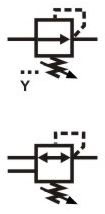Understand the different types of reducing valve and when and where to specify them.
1-2 What pressure reducing valves are used for
Pressure reducing valves are used to provide a stable pressure to part of a circuit that requires a lower pressure than the pumps supply. This may be required because the actuator or loads are not designed to take the full system pressure. Pilot valves may require a lower pressure to that of the main stage.
Often, particularly in mobile equipment, the pilot pressure control feeds are supplied by a pressure reducing valves rather than being limited by pressure relief valves.
1-2 How pressure reducing valves work
Pressure reducing valves don't create pressure, they simply close the flow path to stop the flow when the load pressure reaches the reducing valve's setting. Reducing valves sense the pressure downstream of the valve, unlike relief valves which sense the pressure upstream of the valve.
Some reducing valves have a relief function as well as the reducing function. This means that if the load pressure increases above the reducing valve's setting, it will relieve the pressure from the load.
While using reducing valves may be a more energy efficient approach than using relief valves, they do still convert all of the energy lost from the supply pressure, to the set pressure, into heat.
2 Different types of pressure reducing valve

Pressure reducing valves come in direct and pilot operated versions.
Cartridge, platen or line-mounted valves are also available.
Often the same type of valve is available with different dynamic response rates. This is to provide more stable or faster-responding performance.
3 Tips for operating and maintaining (See Pro course)
Reducing valves may be set to zero pressure when the equipment is delivered. This is to make the equipment safe for commissioning but does mean they need to be reset before use.
Make sure all of the air is vented from the circuit before the valves are set. Any air remaining in the system, perhaps even trapped in manifold galley-ways, can make the system spongy and result in oscillations or vibration.
Watch out for the effects of high pilot flow rates. Some reducing valves require leakage flows to keep them stable and when used in pilot lines, which may expect low flows, these flows and resulting pressure drops may be significant enough to affect other valve settings.
3-4 Typical operating characteristic(See Pro course)
TBC
4 How to specify(See Pro course)
As with most hydraulic valves the direct-operated versions a faster and more dynamic with less internal leakage. The pilot operated versions tend to be more stable and give better characteristics over a higher flow range.
The quality of control and operating environment will probably dictate which design you choose.
Look at the supplier's datasheet to find the most appropriate working range. As a general rule the more expensive, larger valves will give better performance e.g. flatter characteristics. If this is not clear from the datasheet characteristics then look at the design of the valve. You can often see when there has been more attention, and probably testing, paid to the design detail. Although the finer design detail can also be a sign of a valve that will be more sensitive to contamination. See our contamination resistant design section to understand this further.
4 Design Tips, techniques and potential issues
Make sure you have good clearance between reduced pressure and any relief valve reset pressures. Don't forget you may have significant pressure drops in pipework and fittings between different valves.